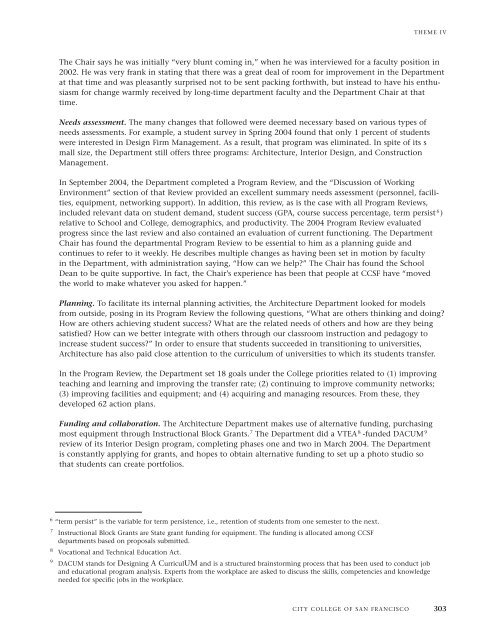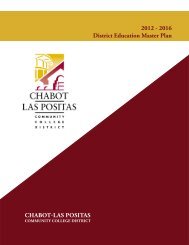City College of San Francisco - California Competes
City College of San Francisco - California Competes
City College of San Francisco - California Competes
Create successful ePaper yourself
Turn your PDF publications into a flip-book with our unique Google optimized e-Paper software.
THEME IV<br />
The Chair says he was initially “very blunt coming in,” when he was interviewed for a faculty position in<br />
2002. He was very frank in stating that there was a great deal <strong>of</strong> room for improvement in the Department<br />
at that time and was pleasantly surprised not to be sent packing forthwith, but instead to have his enthusiasm<br />
for change warmly received by long-time department faculty and the Department Chair at that<br />
time.<br />
Needs assessment. The many changes that followed were deemed necessary based on various types <strong>of</strong><br />
needs assessments. For example, a student survey in Spring 2004 found that only 1 percent <strong>of</strong> students<br />
were interested in Design Firm Management. As a result, that program was eliminated. In spite <strong>of</strong> its s<br />
mall size, the Department still <strong>of</strong>fers three programs: Architecture, Interior Design, and Construction<br />
Management.<br />
In September 2004, the Department completed a Program Review, and the “Discussion <strong>of</strong> Working<br />
Environment” section <strong>of</strong> that Review provided an excellent summary needs assessment (personnel, facilities,<br />
equipment, networking support). In addition, this review, as is the case with all Program Reviews,<br />
included relevant data on student demand, student success (GPA, course success percentage, term persist 6 )<br />
relative to School and <strong>College</strong>, demographics, and productivity. The 2004 Program Review evaluated<br />
progress since the last review and also contained an evaluation <strong>of</strong> current functioning. The Department<br />
Chair has found the departmental Program Review to be essential to him as a planning guide and<br />
continues to refer to it weekly. He describes multiple changes as having been set in motion by faculty<br />
in the Department, with administration saying, “How can we help” The Chair has found the School<br />
Dean to be quite supportive. In fact, the Chair’s experience has been that people at CCSF have “moved<br />
the world to make whatever you asked for happen.”<br />
Planning. To facilitate its internal planning activities, the Architecture Department looked for models<br />
from outside, posing in its Program Review the following questions, “What are others thinking and doing<br />
How are others achieving student success What are the related needs <strong>of</strong> others and how are they being<br />
satisfied How can we better integrate with others through our classroom instruction and pedagogy to<br />
increase student success” In order to ensure that students succeeded in transitioning to universities,<br />
Architecture has also paid close attention to the curriculum <strong>of</strong> universities to which its students transfer.<br />
In the Program Review, the Department set 18 goals under the <strong>College</strong> priorities related to (1) improving<br />
teaching and learning and improving the transfer rate; (2) continuing to improve community networks;<br />
(3) improving facilities and equipment; and (4) acquiring and managing resources. From these, they<br />
developed 62 action plans.<br />
Funding and collaboration. The Architecture Department makes use <strong>of</strong> alternative funding, purchasing<br />
most equipment through Instructional Block Grants. 7 The Department did a VTEA 8 -funded DACUM 9<br />
review <strong>of</strong> its Interior Design program, completing phases one and two in March 2004. The Department<br />
is constantly applying for grants, and hopes to obtain alternative funding to set up a photo studio so<br />
that students can create portfolios.<br />
6 “term persist” is the variable for term persistence, i.e., retention <strong>of</strong> students from one semester to the next.<br />
7 Instructional Block Grants are State grant funding for equipment. The funding is allocated among CCSF<br />
departments based on proposals submitted.<br />
8 Vocational and Technical Education Act.<br />
9 DACUM stands for Designing A CurriculUM and is a structured brainstorming process that has been used to conduct job<br />
and educational program analysis. Experts from the workplace are asked to discuss the skills, competencies and knowledge<br />
needed for specific jobs in the workplace.<br />
CITY COLLEGE OF SAN FRANCISCO<br />
303







